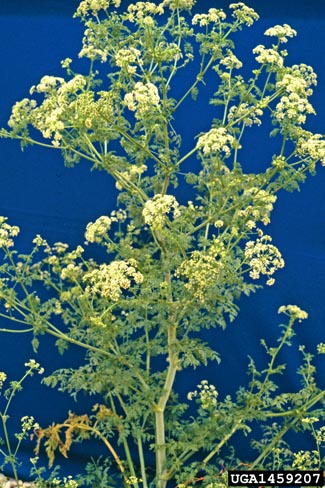Poison Hemlock

Common Name(s):
Poison Hemlock
Scientific Name:
Conium maculatum L.
Scientific Name Synonyms:
None known
Symbol:
COMA2
Description:
Life Span: Biennial
Origin: Introduced
Season: Cool
Growth Characteristics: A forb, native to Europe, growing 5 to 10 feet tall. Stems are erect, stout, and purple-spotted with distinct ridges and extensively branched. Foliage has a strong musky odor.
Flowers/Inflorescence: Flowers are borne in many umbrella-shaped clusters, each supported by a stalk (pedicel). Flowers are white and lacking sepals.
Fruits/Seeds: Seeds are paired, 1/8 inch long, light brown, ribbed and concave.
Leaves: Shiny, green, with the appearance of parsley leaves, growing 6 to 12 inches long. Lower leaves occur on long stalks that clasp the stem. Upper leaves on short stalks.
Ecological Adaptions:
Poison Hemlock occurs on borders of pastures and cropland, gradually invading perennial crops. All plant parts are poisonous including the large white taproot.
Soils: Occurs on wet soils, usually with a water table. It is often found along ditches, in low-lying waste places, and along roadsides. It tolerates poorly drained soils.
Associated Species: Irrigated crops such as alfalfa.
Uses and Management:
Domestic animals are all affected by eating even a small amount of poison hemlock. The leaves are poisonous in the spring, but have a nauseating taste. Livestock seldom eat the plant if other plants are available. Symptoms of poisoning can be violent or chronic, but include staggering, falling, nausea, bloating, and paralyses.
Poison hemlock can be controlled through grubbing or repeated application of herbicides.
Whistles or snorkels made from the hollow stems of these plants have caused illness and death in children.

